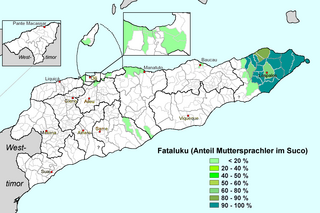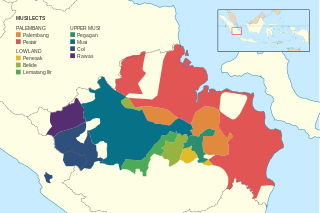Historical linguistics, also known as diachronic linguistics, is the scientific study of how languages change over time. It seeks to understand the nature and causes of linguistic change and to trace the evolution of languages. Historical linguistics involves several key areas of study, including the reconstruction of ancestral languages, the classification of languages into families, and the analysis of the cultural and social influences on language development.

Javanese is a Malayo-Polynesian language of the Austronesian language family spoken primarily by the Javanese people from the central and eastern parts of the island of Java, Indonesia. There are also pockets of Javanese speakers on the northern coast of western Java. It is the native language of more than 68 million people.

In addition to its classical and modern literary form, Malay had various regional dialects established after the rise of the Srivijaya empire in Sumatra, Indonesia. Also, Malay spread through interethnic contact and trade across the south East Asia Archipelago as far as the Philippines. That contact resulted in a lingua franca that was called Bazaar Malay or low Malay and in Malay Melayu Pasar. It is generally believed that Bazaar Malay was a pidgin, influenced by contact among Malay, Hokkien, Portuguese, and Dutch traders.

Carib or Kari'nja is a Cariban language spoken by the Kalina people (Caribs) of South America. It is spoken by around 7,400 mostly in Brazil, The Guianas, and Venezuela. The language is currently classified as highly endangered.

Fataluku is a Papuan language spoken by approximately 37,000 people of Fataluku ethnicity in the eastern areas of East Timor, especially around Lospalos. It is a member of the Timor-Alor-Pantar language family, which includes languages spoken both in East Timor and nearby regions of Indonesia. Fataluku's closest relative is Oirata, spoken on Kisar island, in the Moluccas of Indonesia. Fataluku is given the status of a national language under the constitution. Speakers of Fataluku normally have a command of Tetum and/or Indonesian, those speakers who are educated under Portuguese rule or from younger generation educated under Portuguese-language educational system during independence speak Portuguese.

The Iwaidjan or Yiwaidjan languages are a small family of non-Pama–Nyungan Australian Aboriginal languages spoken in the Cobourg Peninsula region of Western Arnhem Land.

Betawi, also known as Betawi Malay, Jakartan Malay, or Batavian Malay, is the spoken language of the Betawi people in Jakarta, Indonesia. It is the native language of perhaps 5 million people; a precise number is difficult to determine due to the vague use of the name.
Sri Lankan Malay, also known as Sri Lankan Creole Malay, bahasa Melayu, Ja basawa, or Java mozhi, is a Malay-based creole language spoken in Sri Lanka, formed as a mixture of Sinhala and Shonam, with Malay being the major lexifier. It is traditionally spoken by the Sri Lankan Malays, Javanese Sri Lankans, and among some Sinhalese in Hambantota. Today, the number of speakers of the language have dwindled considerably but it has continued to be spoken notably in the Hambantota District of Southern Sri Lanka, which has traditionally been home to many Sri Lankan Malays.

Acehnese is an Austronesian language natively spoken by the Acehnese people in Aceh, Sumatra, Indonesia. This language is also spoken by Acehnese descendants in some parts of Malaysia like Yan, in Kedah. Acehnese is used as the co-official language in the province of Aceh, alongside Indonesian.
Linguistics is the scientific study of language. The areas of linguistic analysis are syntax, semantics (meaning), morphology, phonetics, phonology, and pragmatics. Subdisciplines such as biolinguistics and psycholinguistics bridge many of these divisions.

Palembang, also known as Palembang Malay, is a Malayic variety of the Musi dialect chain primarily spoken in the city of Palembang and nearby lowlands, and also as a lingua franca throughout South Sumatra. Since parts of the region used to be under direct Javanese rule for quite a long time, Palembang is significantly influenced by Javanese, down to its core vocabularies.

Larantuka Malay, also known as Nagi, is a Malay-based creole language spoken in the eastern part of Flores in Indonesia, especially in Larantuka. It is a derivative of Malay which is thought to originate from Malacca. It is a language with unspecified linguistic affiliation. According to 2007 data, this language is spoken by 20,000 speakers, mainly the people of East Flores. Larantuka Malay is the mother tongue of the Nagi people. Then it also functions as a second language for several nearby communities.
Kui is a Timor–Alor–Pantar language spoken in several enclaves on Alor Island, East Nusa Tenggara, Indonesia. The language is called 'Masin lak' in Kui. Although the exact number of speakers is unknown, Kui is an endangered language since speakers are shifting to Alor Malay.

ʼOle, also called ʼOlekha or Black Mountain Monpa, is a moribund, possibly Sino-Tibetan language spoken natively by 1 person in the Black Mountains of Wangdue Phodrang and Trongsa Districts in western Bhutan. The term ʼOle refers to a clan of speakers.

Morori is a moribund Papuan language of the Kolopom branch of the Trans–New Guinea family. It is separated from the other Kolopom languages by the intrusive Marind family. All speakers use Papuan Malay or Indonesian as L2, and many know Marind.
Sahu is a North Halmahera language. Use is vigorous; dialects are Pa’disua (Palisua), Tala’i, Waioli, and Gamkonora. A fifth dialect, Ibu, used to be spoken near the mouth of the Ibu River.

Patwin (Patween) is a critically endangered Wintuan language of Northern California. As of 2021, there was one documented first language speaker of Patwin. As of 2010, Patwin language classes were taught at the Yocha Dehe Wintun Nation tribal school.
The Tutong language, also known as Basa Tutong, is a language spoken by approximately 17,000 people in Brunei. It is the main language of the Tutong people, the majority ethnic group in the Tutong District of Brunei.
Uruangnirin is an Austronesian language spoken on the islands of Tarak and Faor in the Sebakor Bay, West Papua. Some Kalamang people from the neighboring island of Karas speak it as a second language. The languages most closely related to Uruangnirin are Onin and Sekar of the Bomberai Peninsula.

I Wayan Arka is an Indonesian-Balinese linguist, lecturer, scholar and researcher at Udayana University (UNUD) in Bali, Indonesia and the Australian National University (ANU) in Canberra, Australia.















